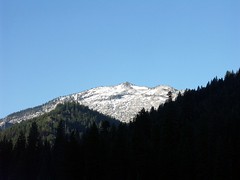Many years ago, I believe that I was 12 years old, I read a compilation of short science fiction stories entitled Universe 5, edited by Terry Carr. I was introduced to some of my favourite authors for the first time, including Ursula K. Le Guin and Fritz Leiber. Leiber's entry was entitled "Mysterious Doings in the Metropolitan Museum", and if I recall correctly, it featured an international convention of beetles at a "metropolitan" museum in New York City. I like to think that Mr. Leiber was in actuality referring to the American Museum of Natural History (that slightly larger but junior cousin of the California Academy of Sciences, ahem). Anyway, what really stuck in my mind about the story was that the cockroaches were excluded. So every morning, as the other beetles headed into the building for their meetings, circles of picketing roaches would march outside chanting "Blat, Blat, Blattidae", Blattidae being one of the taxonomic families of cockroaches. It seems that the poor pests were offended by their continual exclusion from the esteemed college of that most diverse group of animals, the Coleoptera (beetles). What foresight on the part of Mr. Leiber, since we now know that the roaches are far more closely related to termites! But I digress. This is a blog about climate change after all!
Several months ago, one of my fellow scientists here at the Academy, Dave Kavanaugh came into my office with a disturbing but interesting story. Dave is one of the world's foremost beetle experts and had spent some of this past summer revisiting sites in the Sierra Nevada where he had collected beetles more than twenty years ago. Many of these beetles are endemic (unique) to California, and live on or near the ice fields of our high alpine areas. Dave is interested in obtaining more specimens in order to conduct analyses of species DNA. Much to Dave's dismay, many of the areas in which he collected successfully all those years ago are now devoid of snow and ice. The alpine air is warmer, the snow melts earlier, and the ice fields are shrinking. As for the beetles; Dave and his colleagues located some of the species at higher elevation, where the poor bugs are retreating in an effort to track a habitat suitable for their survival. Other species remain missing, and for all we know might now be extinct. The entire story is told far more eloquently here.
Why should we care about these ice beetles? Dave is hooked on beetles; he loves them. My fascination is a bit more abstract (see Le Guin's "Schrodinger's Cat" in Universe 5 for a glimpse into my own mind) and I want to know why we should care about the beetles. Why should we care about any species that is not of obvious benefit to our own species? I can't give you a precise answer for the beetles, but an ecosystem is a complex network of dependencies and interactions. As we lose pieces, as we erode the system, we move closer and closer to points of unpleasant transitions. Need an explanatory analogy? Just think for a moment about a failed Dungeness crab harvest, the monetary cost of fighting insanely ferocious wildfires, and California's ongoing water shortages. It's all connected folks.
By the way, if you'd like to see some of these enigmatic beetles, stop by the Academy's Altered States exhibit. You can watch them trudge about on a miniature ice field, and they're awfully cute.
